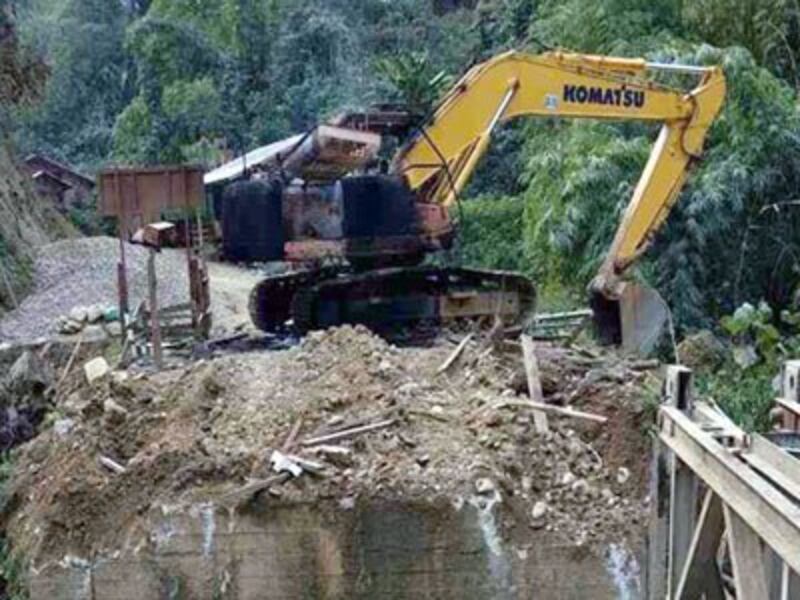The Myanmar army has blocked roadways in the Tanaing township gold and amber mining region during air raids on an ethnic militia in northernmost Myanmar’s Kachin state, trapping more than 3,000 residents and miners in the war-torn area, sources said on Monday.
Government soldiers have regularly clashed with the Kachin Independence Army (KIA), which controls large swathes of territory in the state including the Tanaing area of Myitkyina district, since a 17-year bilateral cease-fire agreement collapsed in 2011.
The hostilities have forced about 100,000 residents to flee to safety over the years, with many seeking shelter in Buddhist monasteries, Christian churches, or displaced persons camps in the state.
Some of the most recent hostilities between the military and KIA have occurred in Tanaing, on whose natural resources the militia depends as a source of income through the levying of a five-percent tax on mine operators. The two sides have also clashed in neighboring northern Shan state.
The government army has said it will deliver food to the thousands of residents and miners who are trapped and send them to safe places, other Tanaing residents said, adding that they themselves have supplied some food for them.
“The [government] army will take the victims by five boats from the intersection of Tanaing Creek and Nangkum Creek,” said Tanaing resident Saw Min Aung. “People from the town will be sent back home today, but the government army will arrange for the people from far-away villages to return the next day.”
Several soldiers on both sides were killed on Sunday when the Myanmar military seized a KIA outpost and customs gate following several days of armed clashes, the online news service Democratic Voice of Burma (DVB) reported.
The Kachin Baptist Convention, a regional Christian organization, said the government army began the offensives, including a series of air strikes, on Jan. 26, killing at least five civilians and injuring many others, the report said.
The Myanmar army air-dropped fliers by helicopter in the Tanaing mining region in June 2017, warning residents and mine workers that they had to leave by mid-month, when it planned to clear the area following a new round of fighting with the KIA.
The fliers also accused the KIA of taking money from mining businesses that should otherwise have gone to the state and said that the mines had destroyed the environment.

KIA destroys bridges
On Sunday, the KIA destroyed two bridges along the road connecting Kachin’s capital Myitkyina to Sumprabung township, about 100 miles away in Putao district, to stall a government army offensive, said Police Lieutenant Colonel Myo Thura Naung from the Kachin State Police.
But San Aung, a member of a peace negotiation team in Myintkyina, said the KIA had destroyed several bridges on the road to stop the attack by government soldiers.
“About 13 KIA soldiers with small arms arrived at Zanankha Bridge and asked road workers to drive a backhoe on the bridge and then they destroyed it with a shear,” Myo Thura Naung said. “They later set the backhoe on fire.”
“Another incident occurred at Bridge No. 1/100,” he said. “Seven KIA members shot a crane’s wheels while it was crossing the bridge, then set the crane on fire.”
The clashes prompted officials to temporarily close schools and forced villagers to flee to safety, Myo Thura Naung said.
The current hostilities, which began in Sumprabung on Jan. 19, forced about 700 ethnic Kachin villagers to leave their homes and seek shelter in a forest, DVB reported last week.
Holding out for peace
The KIA is one of several militias with which the Myanmar government is trying to end decades of ethnic separatist civil wars and forge peace in the country through a series of peace negotiations launched in August 2016 by de facto national leader Aung San Suu Kyi.
The ethnic armed groups have said they want to ensure they have equal rights within a federal union and not forfeit their autonomy to a centralized state in the government’s ongoing peace process.
The KIA is not a signatory to the government-backed Nationwide Ceasefire Agreement (NCA) that eight of the country’s more than 20 armies signed in October 2015. Because of this, it was invited as an observer rather than a participant to the second and most recent peace conference in May 2017. The Myanmar government plans to hold the third round of its 21st-Century Panglong Peace Conference in February.
At the beginning of the year, the Kachin Independence Organization, the KIA’s political wing, reshuffled its top leadership, replacing departing officers with a younger generation of leaders as hostilities between the group’s armed wing and government forces continued to flare up.
Government troops seized 22 KIA outposts, four main camps, and 18 small camps between Nov. 13, 2017, and Jan. 3, and cut off a popular route that it said the rebel group had been using to smuggle timber to China.
Reported by Kyaw Myo Min for RFA’s Myanmar Service. Translated by Khet Mar. Written in English by Roseanne Gerin.
